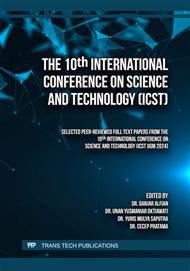[1]
Pusbang BP Batam, Kepri Province With the Largest Influx of Migration, Overtaking Jakarta Due to Employment Opportunities in Batam, available at: https://Pusbang.Bpbatam.Go.Id/Detailpost/Kepri-Provinsi-Dengan-Migrasi-Masuk-Terbesar-Mengalahkan-Jakarta-Karena-Adanya-Kesempatan-Kerja-Di-Batam (accessed May 11, 2023).
Google Scholar
[2]
BPS Kota Batam, Official Statistical Report of the 2020 Population Census Results, BPS Kota Batam, Batam, 2021.
Google Scholar
[3]
S.P. Darlina, B. Sasmito, B.D. Yuwono, Analysis of Urban Heat Island Phenomenon and Its Mitigation (Case Study: Semarang City), J. Geodesi Undip, (2018).
Google Scholar
[4]
D.M. Yow, Urban heat islands: Observations, impacts, and adaptation, Geogr. Compass 1 (2007) 1221-1256.
Google Scholar
[5]
M. Santamouris, Recent progress on urban overheating and heat island research, J. Build. Eng. 29 (2020) 101306.
Google Scholar
[6]
IPCC, Climate Change 2021: The Physical Science Basis, Cambridge University Press, Cambridge, 2021.
Google Scholar
[7]
M.L. Imhoff, P. Zhang, R.E. Wolfe, L. Bounoua, Remote sensing of the urban heat island effect across biomes in the continental USA, Remote Sens. Environ. 114 (2010) 504-513.
DOI: 10.1016/j.rse.2009.10.008
Google Scholar
[8]
W. Zhou, G. Huang, M.L. Cadenasso, Does spatial configuration matter? Understanding the effects of land cover pattern on land surface temperature in urban landscapes, Landsc. Urban Plan. 102 (2014) 54-63.
DOI: 10.1016/j.landurbplan.2011.03.009
Google Scholar
[9]
P.K. Diem, C.T. Nguyen, N.K. Diem, et al., Remote sensing for urban heat island research: Progress, current issues, and perspectives, Remote Sens. Appl. Soc. Environ. 33 (2024) 101081.
DOI: 10.1016/j.rsase.2023.101081
Google Scholar
[10]
Q. Weng, Thermal infrared remote sensing for urban climate and environmental studies: Methods, applications, and trends, ISPRS J. Photogramm. Remote Sens. 64 (2009) 335-344.
DOI: 10.1016/j.isprsjprs.2009.03.007
Google Scholar
[11]
S. Peng, S. Piao, Z. Zeng, P. Ciais, L. Zhou, L.Z.X. Li, et al., Surface urban heat island across 419 global big cities, Environ. Sci. Technol. 46 (2012) 696-703.
DOI: 10.1021/es2030438
Google Scholar
[12]
R. Lukiawan, E.H. Purwanto, M. Ayundyahrini, Standardization of Geometric Correction for Medium-Resolution Satellite Images, J. Standardisasi 21 (2019) 45-54.
Google Scholar
[13]
N.I. Fawzi, Measuring Urban Heat Island Using Remote Sensing: A Case Study in Yogyakarta City, Globë Sci. J. 19 (2017) 195-206.
Google Scholar
[14]
Z. Qin, W. Li, M. Gao, H. Zhang, Estimation of land surface emissivity for Landsat TM6 and its application to Lingxian Region in north China, Remote Sens. Environ. Monit. GIS Appl. Geol. VI 6366 (2006) 292-299.
DOI: 10.1117/12.689310
Google Scholar
[15]
R. Kurnianti, D.H. Rahmi, Availability of Green Open Space and Urban Heat Island in Makassar City, J. Litbang Sukowati 3 (2020) 150-163.
Google Scholar
[16]
I. Hutasoit, Population Growth In Batam Municipality as the Frontier and Outermost Region at the Border Between Indonesia-Singapore-Malaysia, J. Biometrics Popul. 12 (2023) 165-176.
DOI: 10.20473/jbk.v12i2.2023.165-176
Google Scholar
[17]
P. Mohammad, A. Goswami, Quantifying Diurnal and Seasonal Variation of Surface Urban Heat Island Intensity and its Associated Determinants across Different Climatic Zones over Indian Cities, GISci. Remote Sens. 58 (2021) 955-981.
DOI: 10.1080/15481603.2021.1940739
Google Scholar
[18]
H.K. Jabbar, M.N. Hamoodi, M.N. Al-Hameedawi, Urban heat islands: a review of contributing factors, effects and data, IOP Conf. Ser.: Earth Environ. Sci. 1129 (2023).
DOI: 10.1088/1755-1315/1129/1/012038
Google Scholar
[19]
G. Manoli, S. Fatichi, M. Schläpfer, et al., Magnitude of urban heat islands largely explained by climate and population, Nature 573 (2019) 55-60.
DOI: 10.1038/s41586-019-1512-9
Google Scholar


